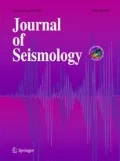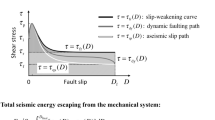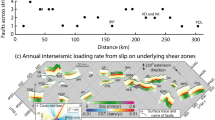Abstract
As usual, earthquake energy is defined as the total energy released from an earthquake, which is partitioned into radiated energy, friction energy, and rupture energy regardless of crustal gravitational potential energy (GPE) change. We analyze the energy and stress parameters in earthquake energy budget. For arbitrarily oriented faults, we deduce the formulas for calculating the normal and shear stresses acting on the fault under principal stresses. We show that shear stress is composed of horizontal and vertical shear stresses. Then, we provide the expressions for computing crustal GPE change and the coefficient of friction. The GPE change should be considered, except strike-slip faulting, when investigating earthquakes. Also, for various faulting types, we show that the ratio of differential stresses is related to the fault orientation and the relative magnitudes of stresses. Finally, “12 May, 2008, Wenchuan, Sichuan, China, MW 7.9 Earthquake” is cited to analyze and calculate various energy/stress parameters and the coefficient of friction. Our result of GPE change coincides with the post-event field observations.


Similar content being viewed by others
References
Abercrombie RE, McGarr A, Toro GD & Kanamori H (2006) Preface. In: Earthquakes: radiated energy and the physics of faulting. Geophys Monogr Ser 170: 327 pp
Aki K (1966) Generation and propagation of G waves from the Niigata earthquake of June 16, 1964. Part 2. Estimation of earthquake moment, from the G wave spectrum. Bull Earthq Res Inst Tokyo Univ 44:73–88
Aki K, Richards PG (1980) Quantitative seismology: theory and methods. Freeman, San Francisco, pp 63–121
Angelier J (1979) Determinition of the mean principal directions of stress for a given fault population. Tectonophysics 56:T17–T26
Angelier J (2002) Inversion of earthquake focal mechanism to obtain the seismotectonic stress IV—a new method free of choice among the nodal planes. Geophys J Int 150:588–609
Barth A, Wenzel F, Giardini D (2007) Frequency sensitive moment tensor inversion for light to moderate earthquakes in eastern Africa. Geophys Res Lett 34:L15302
Beeler NM (2007) Laboratory-observed faulting in intrinsically and apparently weak materials: strength, seismic coupling, dilatancy, and pore-fluid pressures. In: Thrust faults. Dixon T and Moore C (eds) The Seismologenic Zone of Subduction. Columbia University Press
Bott M (1959) The mechanics of oblique slip faulting. Geol Mag 96:109–117
Bizzarri A (2010) On the relations between fracture energy and physical observables in dynamic earthquake models. J Geophys Res 115:B10307. doi:10.1029/2009JB007027
Bizzarri A (2011) On the deterministic description of earthquakes. Rev Geophys 49:RG3002. doi:10.1029/2011RG000356
Bizzarri A, Belardinelli ME (2008) Modelling instantaneous dynamic triggering in a 3-D fault system: application to the 2000 June South Iceland seismic sequence. Geophys J Int 173:906–921. doi:10.1111/j.1365-246X.2008.03765.x
Byerlee JD (1978) Frictions of rocks. Pure Appl Geophys 116:615–629
Carena S, Suppe L, Kao H (2004) Lack of continuity of the San Andreas Fault in southern California: three dimensional fault models and earthquake scenarios. J Geophys Res. doi:10.1029/2003JB002643
Brune JN, Henry TL, Roy RF (1969) Heat flow, stress, and rate of slip along the San Andreas Fault, California. J Geophys Res 74:3821–3827
Chao BF, Gross RS, Dong D-N (1995) Changes in global gravitational energy induced by earthquakes. Geophys J Int 122:784–789
Chinnery MA (1964) The strength of the earth’s crust under horizontal shear stress. J Geophys Res 69(10):2085–2089
Choy GL, Boatwright JL (1995) Global patterns of radiated seismic energy and apparent stress. J Geophys Res 100(B9):18,201–18,228
Dahlen AF (1977) The balance of energy in earthquake faulting. Geophys J R Astron Soc 48:239–261
Dahlen FA, Tromp J (1998) Theoretical global seismology. Princeton University Press, Princeton, 1025pp
Dahm T, Krüger F (1999) High-degree moment tensor inversion using far-field broad-band recordings: theory and evaluation of method with application to 1994 Bolivia deep earthquake. Geophys J Int 137:35–50
Dziewonski AM, Anderson DJ (1981) Preliminary reference earth model. Phys Earth Planet Inter 25:297–356
Dziewonski AM, Chou T-A, Woodhouse JH (1981) Determination of earthquake source parameters from waveform data for studies of global and regional seismicity. J Geophys Res 86:2825–2852
Eshelby JD (1969) The elastic field of a crack extending non-uniformly under general anti-plane loading. J Mech Phys Solids 17:177–199
Fay N, Humphreys E (2006) Dynamics of the Salton blocks: absolute fault strength and crust–mantle coupling in Southern California. Geology 34(4):261–264
Fialko Y, Rivera L, Kanamori H (2005) Estimate of differential stress in the upper crust from variations in topography and strike along the San Andreas Fault. Geophys J Int 160(2):527–532
Flesch LM, Kreemer C (2010) Gravitational potential energy and regional stress and strain rate fields for continental plateaus: examples from the central Andes and Colorado Plateau. Tectonophysics 428:182–192
Gephart JW, Forsyth DW (1984) An improved method for determining the regional stress tensor using earthquake focal mechanism data: application to the San Fernando earthquake sequence. J Geophys Res 89:9305–9320
Gao Q, Wang C, Zhang Y & Ding L (2010) In-situ stress research on prediction and analysis of strong earthquake—repeated in-situ stress measurement on the seismic faults before and after the Wenchuan earthquake of MS 8.0, Special session 1—Wenchuan earthquake: one year after, 20–21. http://people.tamu.edu/~bduan/Duan_2009JB006750.pdf
Hanks TC, Kanamori H (1979) A moment magnitude scale. J Geophys Res 84(B5):2348–2350
Hardebeck JL, Hauksson E (1999) Role of fluids in faulting inferred from stress field signatures. Science 285(5425):236–239
Hardebeck JL, Hauksson E (2001) Crustal stress field in southern California and its implications for fault mechanics. J Geophys Res 106(B10):21859–21882
Hardebeck JL, Michael A (2004) Stress orientations at intermediate angels to the San Andreas Fault, California. J Geophys Res. doi:10.1029/2004JB003239
Hickman S (2009) Structure and properties of the San Andreas Fault at seismogenic depths: recent results from SAFOD experiments. Lectures at University of Colorado at Boulder. http://cires.colorado.edu/events/lectures/hickman/
Hickman SH, Zoback MD, Healy JH (1998) Continuation of a deep borehole stress measurement profile near the San Andreas fault, 1. Hydraulic fracturing stress measurements at Hi Vista, Mojave Desert, California. J Geophys Res 93(B12):15183–15195
Hsu S-K, Lo C-L (2004) Change of crustal gravitational potential energy in the Taiwan orogen by the Chi-Chi earthquake sequence. Earth Planet Sci Lett 222:573–581
Ide S, Beroza GC (2001) Does apparent stress vary with earthquake size? Geophys Res Lett 28(1):3349–3352
Jaeger JC (1956) Elasticity, fracture, and flow. Wiley, New York
Jaeger JC (1969) Elasticity, fracture, and flow, 3rd edn. Methuen, London
Jost ML, Büßelberg T, Jost Ö, Harjes H (1998) Source parameters of injection-induced micro-earthquakes at 9 km depth at the KTB deep drilling site, Germany. Bull Seismol Soc Am 88(3):815–832
Jost ML, Herman RB (1989) A student’s guide to and review of moment tensors. Seism Res Lett 60:37–57
Kanamori H (2001) Energy budget of earthquakes and seismic efficiency, chapter 3. In: Earthquake thermodynamics and phase transformation in the earth’s interior. Academic Press: New York.
Kanamori H, Rivera L (2006) Energy partitioning during an earthquake, in earthquakes: radiated energy and the physics of faulting. Geophys Monogr Ser 170:3–14
Keys WS, Wolff RG, Bredehoeft JD, Shuter E, Healy JH, Healy JH (1979) In-situ stress measurements near the San Andreas Fault in Central California. J Geophys Res 84(B4):1583–1591
Khattri K (1973) Earthquake focal mechanism studies—a review. Earth Sci Rev 9:19–63
Kisslinger C, Bowman JR, Koch K (1981) Procedures for computing focal mechanisms from local (SV/P) data. Bull Seism Soc Am 59:591–601
Kostrov BV (1966) Unsteady propagation of longitudinal shear cracks. J Appl Math Mech Engl Transl 30:1241–1248
Kramer SL (1996) Geotechnical earthquake engineering. Prentice-Hall, Upper Saddle River, p 232
Lachenbruch AH (1986) Simple models for the estimation and measurement of frictional heating by an earthquake. US Geol Surv Open-File Rep 86–508:13
Lachenbruch AH (1988) The stress heat-flow paradox and thermal results from Cajon Pass. Geophys Res Lett 15(9):981–984
Lachenbruch AH & McGarr A (1990) Chapter 10: stress and heat flow. In: Wallace RE (ed) The San Andreas fault system, California. US Geological Survey, Professional Paper 1515. http://3dparks.wr.usgs.gov/pp1515/chapter10.html (2009)
Lachenbruch AH, Sass JH (1980) Heat flow and energetics of the San Andreas Fault Zone. J Geophys Res 85:6185–6222
Liu-Zeng J, Zhang Z, Wen L, Tapponnier P, Sun J, Xing X, Hu G, Xu Q, Zeng L, Ding L, Ji C, Hudnut KW, van der Woerd J (2009) Co-seismic rupture of the 12 May 2008, MS 8.0 Wenchuan earthquake, Sichuan: east–west crustal shortening on oblique, parallel thrusts along the eastern edge of Tibet. Earth Planet Sci Lett 286(3–4):355–370
Locker DA, Okubo PG (1983) Measurements of frictional heating in granite. J Geophys Res 88(B5):4313–4320
Lund B, Townwnd J (2007) Calculating horizontal stress orientations with full or partial knowledge of the tectonic stress tensor. Geophys J Int 170:1328–1335
Mayeda K, Malagnini L (2009) Apparent stress and corner frequency variations in the 1999 Taiwan (Chi-Chi) sequence: evidence for a stepwise increase at MW ~5.5. Geophys Res Lett. doi:10.1029/2009GL037421
McGarr A (1980) Some constraints on levels of shear stress in the crust from observations and theory. J Geophys Res 85(B11):6231–6238
McGarr A (1988) On the lithosphere stress in the absence of applied tectonic forces. J Geophys Res 93(B11):13609–13617
McGarr A, Gay NC (1978) State of stress in the earth’s crust. Annu Rev Earth Planet Sci 6:405–436
McGarr A (1999) On relating apparent stress to the stress causing earthquake fault slip. J Geophys Res 104(B2):3003–3011
McGarr A, Zoback MD, Hanks TC (1982) Implications of an elastic analysis of in situ stress measurements near the San Andreas fault. J Geophys Res 87:7797–7806
Michael A (1987) Use of focal mechanisms to determine stress: a control study. J Geophys Res 92:11,517–11,526
Michael A (1990) Energy constraints on kinematic models of oblique faulting—Loma-Prieta versus Parkfield-Coalinga. Geophys Res Lett 9:1453–1456
Morrow C, Radney B & Byerlee J (1992) Chapter 3 frictional strength and the effective pressure law of montmorillonite and illite clays. In: Fault mechanics and transport properties of rocks. Academic Press. http://earthquake.usgs.gov/research/physics/lab/Frictional_strength.pdf (2009)
Mount V, Suppe J (1987) State of stress near the San Andreas fault: implications for wrench tectonics. Geology 15:1143–1146
Okamoto T, Tanimoto T (2002) Crustal gravitational energy change caused by Earthquakes in the western United States and Japan. Earth Planet Sci Lett 195:17–27
Pittarello L, Di Toro G, Bizzarri A, Pennacchioni G, Hadizadeh J, Cocco M (2008) Energy partitioning during seismic slip in pseudotachylytes-bearing faults (Gole Larghe Fault, Adamello, Italy). Earth Planet Sci Lett 269:131–139. doi:10.1016/j.epsl.2008.01.052
Rivera L, Cisternas A (1990) Stress tensor and fault plane solutions for a population of earthquakes. Bull Seism Soc Am 80:600–614
Rivera L, Kanamori H (2002) Spatial heterogeneity of tectonic stress and friction in the crust. Geophys Res Lett. doi:10.1029/2001GL013803
SAFOD (2008–2010) Please see San Andreas Fault Observatory at Depth conducted measurements and experiments in 2008–2010 at its web site: http://www.safod.com
Savage JC, Walsh JB (1978) Gravitational energy and faulting. Bull Seism Soc Am 68(6):1613–1622
Scholz CH (2000) Evidence for a strong San Andreas fault. Geology 28(2):163–166
Stein S, Wysession M (2003) An introduction to seismology, earthquakes, and earth structure. Blackwell, New York
Tanimoto T, Okamoto T (2000) Change of crustal potential energy by earthquakes: an indicator for extensional and compressional tectonics. Geophys Res Lett 27:2313–2316
Townend J, Zoback M (2000) How faulting keeps the crust strong. Geology 28:399–4402
Townend J, Zoback M (2004) Regional tectonic stress near the San Andreas fault in central and southern California. Geophys Res Lett 31:Art No. L15S11. doi:10.1029/2003GL018918
Townend J, Zoback MD (2006) Stress, strain, and mountain building in central Japan. J Geophys Res 111:B03411
USGS (2009) Seismic moment. http://earthquake.usgs.gov/learning/glossary.php?term=seismic_moment or http://earthquake.usgs.gov/regional/qfaults/glossary.php
USGS (2008) Magnitude 7.9 Eastern Sichuan, China, 2008 http://neic.usgs.gov/neis/eq_depot/2008/eq_080512/neuc_ryan_hry.html
Vavryčuk V (2011) Tensile earthquakes: theory, modeling, and inversion. J Geophys Res 116:B12320. doi:10.1029/2011JB008770
Venkataraman A, Kanamori H (2004) Observational constraints on the fracture energy of subduction zone earthquakes. J Geophys Res 109:B05302
Wu M, Zhang Y, Liao C, Chen Q, Ma Y, Wu J, Yan J, Ou M (2009) Preliminary results of in-situ stress measurements along the Longmenshan fault zone after the Wenchuan MS 8.0 earthquake. Acta Geol Sin 83(4):746–753
Xu Z, Ji S, Li H, Hou L, Fu X, Cai Z (2009) Uplift of the Longmen Shan range and the Wenchuan earthquake. Episodes 31(3):291–301
Yamashita T (2000) Generation of microcracks by dynamic shear rupture and its effects on rupture growth and elastic wave radiation. Geophys J Int 143:395–406
Zoback MD (1992) First- and second-order pattern of stress in the lithosphere: the World Map project. J Geophys Res 97:11,703–11,728
Zoback MD, Haimson BC (eds) (1983) Hydraulic fracturing stress measurements. National Academy Press, Washington
Zoback MD, Tsukahara H, Hickman SH (1980) Stress measurements at depth in the vicinity of the San Andreas Fault: implications for the magnitude of shear stress at depth. J Geophys Res 85(B11):6157–6173
Zoback MD, Zoback ML (1980) State of stress in the conterminous United States. J Geophys Res 85(B11):6113–6156
Zoback MD, Zoback ML, Mount VS, Suppe J, Eaton JP, Healy JH, Oppenheimer DH, Reasenberg PA, Jones LM, Raleigh CB, Wong LG, Scotti O, Wentworth CM (1987) New evidence on the state of stress of the San Andreas fault system. Science 228(4830):1105–1111
Zoback MD, Barton CA, Brudy M, Castillo DA, Finkbeiner T, Grollimund BR, Moos DB, Peska P, Ward CD, Wiprut DJ (2003) Determination of stress orientation and magnitude in deep wells. Int J Rock Mech Min Sci 40:1049–1076
Author information
Authors and Affiliations
Corresponding author
Additional information
A comment to this article is available at http://dx.doi.org/10.1007/s10950-014-9443-2.
Rights and permissions
About this article
Cite this article
Zhu, P.P. Normal and shear stresses acting on arbitrarily oriented faults, earthquake energy, crustal GPE change, and the coefficient of friction. J Seismol 17, 985–1000 (2013). https://doi.org/10.1007/s10950-013-9367-2
Received:
Accepted:
Published:
Issue Date:
DOI: https://doi.org/10.1007/s10950-013-9367-2




